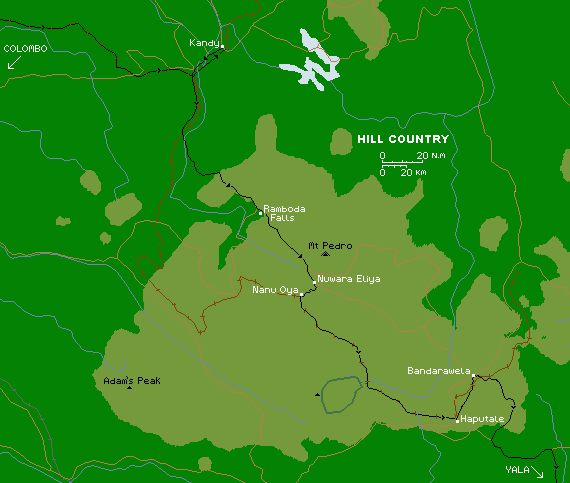
The highlands of central Sri Lanka. Tea is the principle crop here
|
Indian Landfalls Sri Lanka Pages Related Pages SL NewslettersSL Cruising Info SL Flora & Fauna |
Hill Country
 The highlands of central Sri Lanka. Tea is the principle crop here |
Landscape: Rugged mountains to 2524m (8330ft) covered in native
hardwood and bamboo forest. Rolling hills cultivated with tea and hardy
vegetables. Deep river gorges. Green, green, green and cool.
Visited: March 13 to 18, 2007. We left Ocelot tied to the
floating dock inside the secure harbor in Galle.
Much of this area is also covered in our Sri Lanka Interior newsletter where you'll find other photos (including more of us!) plus more details on train rides.
(Jon) Our trip through the Sri Lankan highlands was a highlight, and one of the main reasons we came to Sri Lanka. The route we planned took us from Galle in the SW corner up to the capital of Colombo, then inland (and up!) to Kandy. We spent several days exploring the interior highlands and then descended to Yala National Park and wildlife refuge in the SE corner before coming back to Galle via the southern coast road. Although we were offered an air conditioned van and driver for only $35/day (quite a steal, as the going rate was closer to $50/day) we decided instead to immerse ourselves more completely in our Sri Lankan experience by taking public transportation.
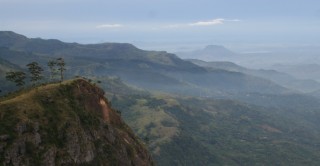 View near Lipton's Seat, over the escarpment |
The highlands, of course, have much less frenetic activity than the cities of Galle or Colombo. We could take the time to walk around the lake in Kandy past the Temple of the Tooth where one of Buddha's molars is supposed to reside, spend a quiet afternoon in the Botanic Gardens, walk through the foggy tea-fields to Lipton's Seat where Sir Thomas Lipton (of tea fame) liked to take in the glorious view looking down over the escarpment, or take a private, guided tour through a tea-factory to learn how tea is produced and graded. The train-ride from Nanu Oya to Haputale, highest in the country, tends to run along mountain ridges, giving superb views on both sides. Lush jungle vegetation with native rhododendrons alternated with small villages and neatly trimmed fields of tea plants (actually a type of Camellia).
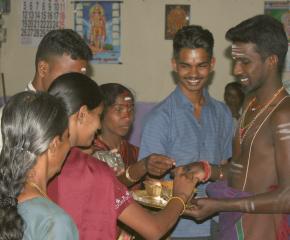 A Hindu baby blessing ceremony |
(Sue) Getting up to Kandy was a repeat of some of the travels Jon and I took in 1980, but this time we wandered much farther off the beaten track, making a loop back down to the coast. Kandy, though touristy, is alive with the aura of old Ceylon: bullock carts mingle with the cars, pilgrims come to the Temple of the Tooth Relic, couples and families stroll the old walkways that surround Kandy Lake under the watchful eyes of the Buddha that rests on the hilltop.
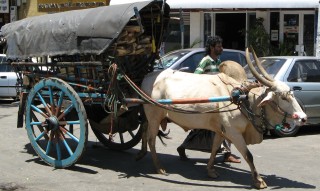 Bare feet, and bullock carts in Kandy |
With not many days to spare before Christopher flew home, we had to pick and choose how to spend our time. Unfortunately, both Jon and Chris left the Lakshmi Guest House in the morning dressed in shorts, which meant they were not allowed onto the grounds or into the enclosure of the Temple of the Sacred Tooth Relic (long slacks or sarong are required). So we spent an hour or more strolling the lake edge, photographing the many egrets and fruit bats that roosted in the trees, then found lunch at Devon Restaurant on the busy main street. We took a local bus (20 cents) to the Peradeniya Botanic Gardens which was supposed to be a 10 minute ride, but with all the congested traffic (the schools were just getting out for the day) it took almost an hour. It was a shame to feel rushed through the fantastic gardens where we walked under the huge coco-de-mer palms, explored the fortress of roots formed by the century-old ficus tree, clattered part way across a swinging bridge (under armed guard escort) over the Mahaweli Ganga, and enjoyed the antics of the hundreds of huge fruit bats in the trees who were just waking up for their evening's flight.
 Fruit bats resting high in the Garden trees |
Arranged by our guest house manager, Malik, we took a car and driver from Kandy to Nanu Oya where we wanted to catch the afternoon train along the ridges to Haputale. We could have gone by train for a fraction of the cost, but we had had several days of trains, with more to come, so we splurged on the private van. It was great to be able to request photo stops along the road, stop and stretch our legs and explore wayside temples in the small towns. We hiked to Ramboda Falls and took a tour of Blue Field Tea Plantation factory (which seemed to be operating just barely enough to show the tourists how tea processing worked). The tour was free and included an elegant, sit-down, authentic Blue Field cuppa. It's one of the few times I've taken black tea without milk and enjoyed it! Of course we bought their tea after that, which was probably the whole point of the tour.
 Tea "withering" in the Dambatenne Factory |
Just being in highlands with cool mountain air was a fantastic change from the mugginess and heat of the coast. In Haputale our family made up about half the total guests at the Amarasinghe Guest House that sat high on a cool misty ridge. The inn is both private home and guest house, with some 12 rooms with high ceilings, fans, and balconies. Because of its distance to the town (and the fact that the town offers little in the way of restaurants) the delicious meals are home-cooked by Mrs. Amarasinghe. The owner and his wife were gracious (as were all the other guest house owners, in fact!) and arranged a van to take us to the Lipton/Dambatenne Tea Factory the next morning. Winding higher and higher through the cultivated tea fields is breathtakingly beautiful. Unlike Blue Field Tea Plantation this one was a truly working factory, built in 1890 by Sir Thomas Lipton, and running ever since. We four were the only visitors and we were required to wear white lab coats while touring the sorting, drying, crushing, and packaging rooms. When we asked if the tour (which cost $2 each) included a cup of tea, the manager, who was acting as tour guide, laughed. No, this was definitely not a tourist event!
 Our narrow road down the Ella Gap |
From Haputale we splurged on a $5 car and driver to get to the bus-junction town of Bandarawela so we could scoot through a road-black that required everyone on a public bus to disembark, pass through an inspection station, then re-board. By driving, (and looking like obvious tourists) we were able to save half an hour. From Bandarawela our public bus experience was really an adventure. These small hill towns don't have central bus stations, so you have to find someone to help figure out where to stand on the street to get the bus and which bus to take. With all the bus destination signs in Sinhala with its beautiful (but unreadable, to us) rounded script it is quite a challenge! Somehow, with only one bus change (and time for a quick lunch!) we found ourselves on the big red public bus headed for the coast. The route from Bandarawela to Welimada (where you change for a bus to the coast) goes down the infamous Ella Gap, an amazing feat of road-building that contours steep cliffs with 1,000 foot (300m) drops to the river valley and around hair-pin turns through lush forest. It was several hours of white-knuckle riding, with the four of us getting more and more punchy. We calculated that a one-second gap before a head-on collision with another bus was considered an acceptable margin of safety. Even on the flat roads at the bottom of the Gap the driver seemed intent on being the fastest bus on the road, passing with wild abandon, even when he could see an on-coming truck or bus or unfortunate bicyclist or pedestrian. I am still amazed that we didn't kill someone (or all of us) on that ride! Ahhh, nothing like a great adventure. Plus it saved tons of money to take busses -- the 5 hours to the coast cost about $2 for the 4 of us, whereas a car and driver would have been 25 times that much!
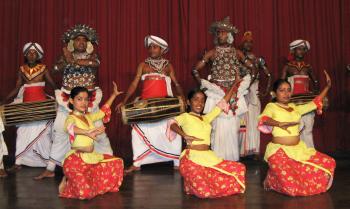 Kandian dancers and drummers after the show |
(Amanda) It was wonderful to get up into the cool fresh air of the hill country. Even Kandy, with its many guest houses and restaurants and tourist traps was cute and fun. The botanic gardens just outside town were nice and quiet, as was our stroll around the lake. Later that evening we saw a Kandian dance show at the YMBA, which was impressively energetic. The women did dances very similar to the Indonesian harvest dances, but with a few differences that I couldn't quite put my finger on. The men, however, with long flowing white skirt-like sarongs and bells and shiny metal bands, did the most awesome dances and acrobatic runs and leaps and flips. The drummers all wore turbans and were pounding away on their double-ended drums with wild abandon, muscled and sinewy arms moving too fast to see - even one old, toothless guy.
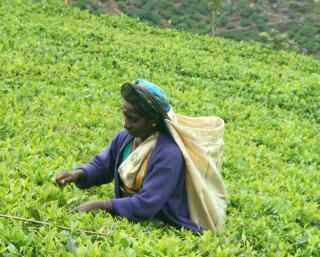 A tea picker at Dambatenne Factory |
Driving through the tea hills was fantastic. From afar, the hills look beautifully green and lush, like perfectly trimmed lawns. Closer up, the rows of tea plants are distinct, sometimes curving gracefully around boulders or rocks protruding from the hillside, and dotted with random pine trees. Not many fields that we passed were being worked, so it was a treat to get to Dambatenne (Lipton's) Tea Factory, where we were welcome to go see the working fields. Mom and I spent over half an hour walking through the tea plants, talking to the (female) pickers and the (male) overseers at the top of the hill and taking pictures and enjoying the view over the escarpment as the clouds swept in.
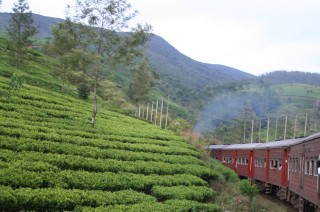 Tea fields, hills and the train to Haputale |
The train rides were fun, though the 'first class' observation car on the trip to Kandy left much to be desired - the last car on the train, all seats facing backwards staring straight into the sun through a massive window, no air conditioning, bumping and swaying like the tail end of a happy dog. We learned to buy second-class tickets and stand in the doorways, feeling the cool air and enjoying the magnificent views without hindrance except for stepping aside briefly to let people on and off.
The cool, moist lushness of the hill country captivated me, and I definitely could have stayed longer. Check out my Sri Lanka Journal for more on our inland trip.
Top Level: Home | Destinations | Cruising Info | Underwater | Boat Guests | Ocelot | Sue | Jon | Amanda | Chris | Site Map | Make a Comment
|
If our information is useful, you can help by making a donation |
Copyright © 2000‑ Contact: Jon and Sue Hacking -- HackingFamily.com, svOcelot.com. All rights reserved.